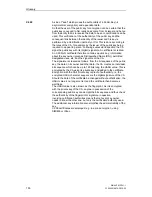
Glossary
SINAUT MD741-1
144
C79000-G8976-C236-05
GPRS
GPRS is the abbreviation for "General Packet Radio Service", a data
transmission system of GSM2+ mobile phone systems. GPRS systems
use the basestations of GSM networks as their wireless equipment,
and their own infrastructure for coupling to other IP networks, such as
the Internet. Data communication is packet-oriented; the Internet
Protocol (IP) is used. GPRS provides data rates of up to 115.2 KBit/s.
GSM
GSM (= Global System for Mobile Communication) is a standard that is
used worldwide for digital mobile phone networks. In addition to the
voice service for telephone calls, GSM supports various data services,
such as fax, SMS, CSD and GPRS. Depending on the legal
requirements in the various countries, the frequency bands 900 MHz,
1800 MHz or 850 MHz and 1900 MHz are used.
HTTPS
HTTPS (=HyperText Transfer Protocol Secure) is a variant of the
familiar HTTP, which is used by any Web browser for navigation and
data exchange in the Internet.
In HTTPS the original protocol is supplemented with an additional
component for data protection. While in HTTP data are transmitted
unprotected in plain text, in HTTPS data are transmitted only after an
exchange of digital certificates, and in encrypted form.
IP address
Every host or router on the Internet / an intranet has a unique IP
address (IP = Internet Protocol). The IP address is 32 bits (= 4 bytes)
long, and is written as 4 numbers (each in the range from 0 to 255),
which are separated from each other by dots.
An IP address has 2 parts: the network address and the host address.
All hosts of a network have the same network address, but different
host addresses. Depending on the size of the network in question - a
distinction is made between networks of Class A, B and C - the two
address components may be of different sizes:
1st byte
2nd byte
3rd byte
4th byte
Class A
Netw. addr.
Host addr.
Class B
Netw. addr.
Host addr.
Class C
Netw. addr.
Host addr.
It can be seen from the first byte of the IP address whether the IP
address designates a network of Class A, B or C. The following
definitions apply:
Value of the
1st byte
Bytes for the
network address
Bytes for the
host address
Class A
1-126
1
3
Class B
128-191
2
2
Class C
192-223
3
1
If you do the arithmetic, you can see that there can be a maximum of
126 Class A networks worldwide, and each of these networks can
comprise a maximum of 256 x 256 x 256 hosts (3 bytes of address
space). There can be 64 x 256 Class B networks, each of which can
contain up to 65,536 hosts (2 bytes of address space: 256 x 256).
There can be 32 x 256 x 256 Class C networks, each of which can
contain up to 256 hosts (1 byte of address space).







































